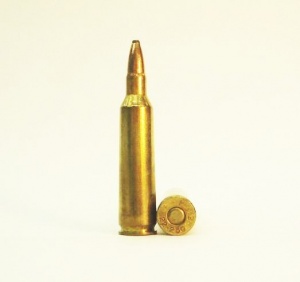Difference between revisions of ".22-250 Remington"
m (22-250 moved to .22-250 Remington: correct naming) |
m (1 revision) |
Latest revision as of 14:23, 15 March 2013
| .22-250 Remington | |||||||||||||||||||
|---|---|---|---|---|---|---|---|---|---|---|---|---|---|---|---|---|---|---|---|

| |||||||||||||||||||
| Type | Rifle | ||||||||||||||||||
| Country of Origin | USA | ||||||||||||||||||
| Specifications | |||||||||||||||||||
| Parent Case | .250-3000 Savage | ||||||||||||||||||
| Bullet Ø | .224 in (5.7 mm) | ||||||||||||||||||
| Neck Ø | .254 in (6.5 mm) | ||||||||||||||||||
| Shoulder Ø | .414 in (10.5 mm) | ||||||||||||||||||
| Base Ø | .469 in (11.9 mm) | ||||||||||||||||||
| Rim Ø | .473 in (12.0 mm) | ||||||||||||||||||
| Case Length | 1.912 in (48.6 mm) | ||||||||||||||||||
| Full Length | 2.35 in (60 mm) | ||||||||||||||||||
| Rifling twist | 1-12, 1-14 | ||||||||||||||||||
| Primer | Large rifle | ||||||||||||||||||
| Production & Service | |||||||||||||||||||
| Designer | Grosvenor Wotkyns, J.E Gebby & J.E. Smith | ||||||||||||||||||
| Design Date | 1937 | ||||||||||||||||||
| Manufacturer | Remington | ||||||||||||||||||
| Production Dates | 1965-Present | ||||||||||||||||||
| Variants | .22-250 Ackley Improved | ||||||||||||||||||
| Ballistic Performance Sampling | |||||||||||||||||||
| |||||||||||||||||||
Contents |
[edit] History
The .22-250 started life as a wildcat cartridge developed from the .250 Savage case necked down to take a .224 caliber bullet. In the early days of the cartridge there were several different versions that varied only slightly from one to the next, including one developed in 1937 by Grosvenor Wotkyns, J.E. Gebby and J.E. Smith who named their version the 22 Varminter.[2]
The .22-250 is very similar to but slightly outperformed (approx 100 ft/s) by the longer .220 Swift cartridge. However, it is in much wider use and has a larger variety of commercially available factory ammunition than the Swift. This makes it generally cheaper to shoot. The smaller powder load also contributes to longer barrel life, an important factor for high-volume shooters.
In 1937 Phil Sharpe, one of the first gunsmiths to build a rifle for the .22-250 and long time .220 Swift rifle builder, stated "The Swift performed best when it was loaded to approximately full velocity," he wrote, whereas, "The Varminter case permits the most flexible loading ever recorded with a single cartridge. It will handle all velocities from 1,500 ft/s up to 4,500 ft/s."[3]
Sharpe credited the steep 28-degree shoulder for this performance. He insisted that it kept the powder burning in the case rather than in the throat of the rifle, as well as prevented case stretching and neck thickening. "Shoulder angle ranks along with primer, powders, bullets, neck length, body taper, loading density and all those other features," he wrote. "The .22 Varminter seems to have a perfectly balanced combination of all desirable features and is not just an old cartridge pepped up with new powders."[3]
Accuracy was consistently excellent, with little need for either case trimming or neck reaming, and Sharpe pronounced it "my choice for the outstanding cartridge development of the past decade." He finished by saying he looked forward to the day when it would become a commercial cartridge.[3]
[edit] Commercial acceptance
In 1963 the Browning Arms Company started to chamber its Browning High Power Rifle in the .22-250, at the time a wildcat cartridge. A risky yet historical move on Browning's part as there was no commercial production of the .22-250 at the time. John T. Amber, reporting on the development of Brownings rifle in the 1964 Gun Digest, called the event "unprecedented." "As far as I know," he wrote, "this is the first time a first-line arms-maker has offered a rifle chambered for a cartridge that it--or some other production ammunition maker--cannot supply." Amber foresaw difficulties for the company but "applauded Browning's courage in taking this step." He said he had his order in for one of the first heavy-barrel models, expected in June 1963, and added, "I can hardly wait!"[3]
Two years later in 1965 Remington Arms adopted the .22-250, added "Remington" to the name and chambered their Model 700 and 40 XB match rifles for the cartridge along with a line of commercial ammunition, thus establishing its commercial specification.
The .22-250 was the first non-Weatherby caliber offered in the unique Weatherby Mark V rifle.
[edit] Performance
The factory-loaded .22-250 Remington can propel a 55 grain (3.56 g) spitzer bullet at 3,680 ft/s (1122 m/s) with 1,654 ft·lbf (2,243 J) of energy [4]. Many other loads with lighter bullets are used to achieve velocities of over 4,000 ft/s (1,219 m/s), while still having effective energy for use in hunting small game and medium sized predators.
It is particularly popular in the western states of the USA where high winds often hinder the effectiveness of other varmint rounds in prairie dog hunting. Many states in the USA have minimum caliber restrictions limiting the use of this cartridge on larger game such as deer.
[edit] See also

[edit] References
- ↑ Hodgdon Online reloading data
- ↑ 2.0 2.1 Cartridges of the World 8th Edition, Book by Frank C. Barnes, DBI Books, 1997, ISBN 0-87349-178-5
- ↑ 3.0 3.1 3.2 3.3 The Great .22-250 by Terry Wieland
- ↑ The .22-250 by Chuck Hawks